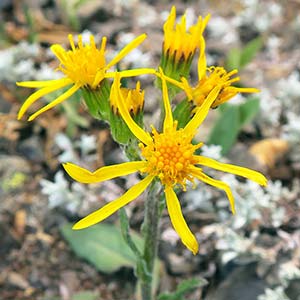Senecio mohavensis
Senecio lugens
Mohave groundsel, Mojave ragwort
black-tip groundsel, small blacktip ragwort
(sometimes purple-tinged) glabrous.
loosely, often unevenly, floccose-tomentose, glabrescent.
usually 1 (freely branching upward).
single or clustered.
equally distributed; petiolate;
blades ovate to obovate, 2–6 × 0.5–2(–4) cm, bases tapered, margins coarsely lobed or irregularly dentate (mid and distal leaves similar, bases expanded, truncate to cordate, clasping, 1–2 cm across).
reduced distally; petiolate;
blades narrowly obovate to oblanceolate, (4–)8–18(–25) cm, bases tapered, margins subentire to dentate (denticles callous; mid and distal leaves bractlike, clasping).
0 or 1–3+;
corolla laminae 0.1–1 mm (little expanded, barely, if at all, surpassing phyllaries; sometimes laminae 0 and heads perhaps technically disciform).
(± 5) ± 8 (± 13);
corolla laminae 8–10(–15) mm.
± 8 or ± 13, 6–7 mm, tips green.
(± 8) ± 13 (± 21), 4–7 mm, tips black.
of 3–5+ lance-linear bractlets.
of 2–5 linear bractlets (1–2 mm).
3–10 in loose, cymiform arrays.
(2–)7–12(–20+) in corymbiform arrays.
hairy.
glabrous.
= 40.
= 40, 80.
Senecio mohavensis
Senecio lugens
Senecio mohavensis is similar to S. flavus (Decaisne) Schultz-Bipontinus of the Mediterranean region and southwest Asia, which raises phytogeographic questions (cf. A. Liston et al. 1989; Liston and J. W. Kadereit 1995; M. Coleman et al. 2001). The last cited study showed that a previously recognized variety of S. flavus is more closely related to S. mohavensis than to S. flavus and a new combination was made: S. mohavensis subsp. brevifolius (Kadereit) M. Coleman.
(Discussion copyrighted by Flora of North America; reprinted with permission.)
Senecio lugens varies greatly in robustness across its range. It is scattered widely in the Rocky Mountain uplift and adjacent regions from northern Wyoming to Alaska; it is disjunct in the Olympic Peninsula, Washington. Superficially similar to S. integerrimus, S. lugens has well-developed, coarse, spreading rootstocks with branching roots; S. integerrimus arises from foreshortened, buttonlike caudices with abundant unbranched, fleshy-fibrous roots.
(Discussion copyrighted by Flora of North America; reprinted with permission.)


